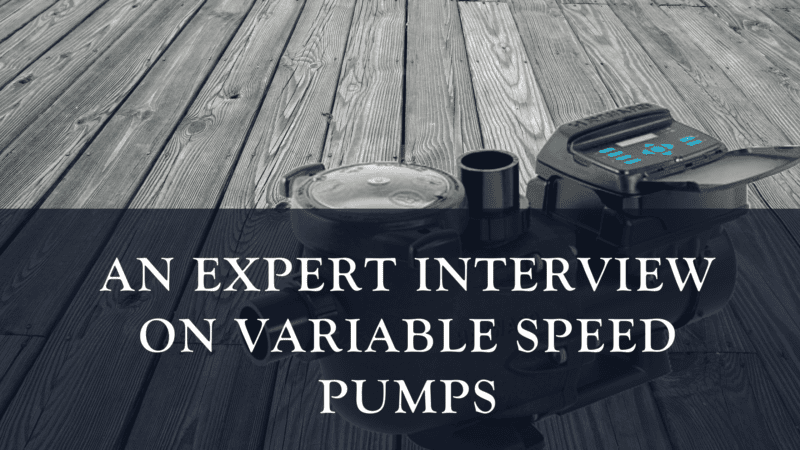An Expert Interview about Variable Speed Pumps

Energy efficiency has been on the rise for a few years now and so many people are looking for ways to cut costs, especially in this time of a global pandemic.
Welcome to Variable Speed Pumps! VSP’s have been available for several years now and is included in all R&R Pools new builds, but those with older pools may be wondering why they should make the switch over to a VSP. This blog takes us on an expert interview with Hayward’s William Jasnich to discuss the benefits of a variable speed pump over a single speed pump, as well as other questions you didn’t even know you had!
Variable Speed Pumps (VSP)
What are the advantages of a variable speed pump?
WJ: Simply put, Variable Speed Pumps (VSPs) result in a significant reduction in energy consumption. As VSPs provide a scalable range of speed, the appropriate flow rates may be achieved to ensure the body of water is efficiently circulated. Further, the slower the speed the quieter the operation and the potential for a quick payback period by reducing the cost of hydro.
How does a variable speed pump save energy?
WJ: The Affinity Law uses physics to predict how changes in velocity will affect the pump head, flow, and power consumption. The change in flow is proportional to the change in speed. The change in head is proportional to the square of change in speed. The change in energy use is proportional to the cube of the change in speed.
While this might be confusing, this is a simplified answer. At ½ speed of filter pump, we achieve approximately ½ the flow. This equates to ¼ the head in feet as slower moving water creates lower TDH (Total Dynamic Head). This results in 1/8 of power consumption as it is proportional to the cube of the change in speed. The energy consumption is slashed to ¼ (75% savings) at the same turnover rate using twice the run time.
What speed should a variable speed pump be set at?
WJ: The parameters are determined by the required flow rates. Although, a simple answer would be the required speed to trigger the heater and salt system if applicable (with no Omni platform available to automate this process).
Some clients prefer to run the pump during the day only, to save money on their power bill, does a VSP need to run 24/7?
WJ: VSPs are not required to run 24/7. Once calculating the approximate turnover rate for the swimming pool each day, the desired speed and gallons per minute can be determined. This in turn will dictate how many hours a day the pool is required to operate at a predetermined speed.
Why would someone want to change the speed their pump is running at? With a single speed pump, they can set and forget it.
WJ: The conversation is about energy consumption. The VSP is fully programmable through its intuitive digital display so clients can set it and forget it.
Some clients are having an issue with making the switch from a single speed pump to a variable speed pump due to the price difference. Can you shed some light on the monetary benefits of opting for a variable speed pump?
WJ: Opting for a Variable Speed Pump will result in the potential for a very short payback period. As we learned, VSPs operate at a lower speed, which in effective reduces total energy consumption leading to a lower hydro bill. This lower consumption will begin to pay the added cost of upgrading to a VSP versus a single speed pump operating at one fixed speed.
Select jurisdictions offer generous hydro rebate programs similar to the Poolsaver program. Ask your dealer for further details.
Is there any maintenance required to a VSP pump?
WJ: General maintenance rules apply to VSPs as they would to single speed pump options. Clean the basket weekly if necessary; ensure debris does not build up around the motor; address any water leaks from seals to prevent motor bearing failures; and avoid storing chemicals nearby pump as this may corrode parts of the motor.
Do you have any other thoughts to share concerning variable speed pumps and their advantages?
WJ: In addition to significant energy savings, running a pump at lower speeds has even more benefits, including:
- Less stress on the plumbing system which may lengthen the life of equipment.
- Longer pump cycles keeping chemicals in circulation longer and allowing the heater and salt chlorinator to function at any given time of the day necessary
- Hayward VSPs are recognized several years running as a Top Energy Star Partner
Do you have any other tips on variable speed pumps that you would like to share?
WJ: As a recap, VSPs result in significant energy savings with the pump paying for itself overtime; the slower the speed the quieter the operation; slower the flow the better the filtration; ability to adjust flow to exactly what is required; programmable speeds & timers; potential generous rebates in select areas; rotatable keypads and wall-mountable displays.
Thank you for taking the time to answer our questions Will!
If you have any other questions or want to know more about Variable Speed Pumps for your pool, you can reach us at info@rrpools.ca or call us at (902)876-2773.
